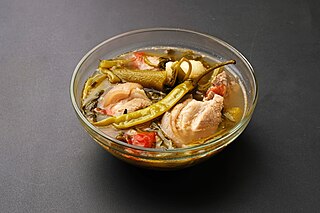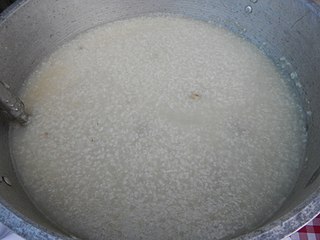
Corn soup is a soup made of corn, typically sweetcorn. Initially popular only in corn-producing areas of the world, the dish is now widespread because of greater corn distribution. Typical ingredients are corn cut from the cob, water, butter and flour, with salt and pepper for seasoning. Additional ingredients vary by region, and may include eggs.

Sinigang is a Filipino soup or stew characterized by its sour and savory taste. It is most often associated with tamarind, although it can use other sour fruits and leaves as the souring agent such as unripe mangoes or rice vinegar. It is one of the more popular dishes in Filipino cuisine. This soup, like most Filipino dishes, is usually accompanied by rice.

Ginataan, alternatively spelled guinataan, is a Filipino term which refers to food cooked with gatâ. Literally translated, ginataan means "done with coconut milk". Due to the general nature of the term, it can refer to a number of different dishes, each called ginataan, but distinct from one another.

Lugaw, also spelled lugao, is a Filipino glutinous rice dish or porridge. Lugaw may refer to various dishes, both savory and sweet. In Visayan regions, savory lugaw are collectively referred to as pospas. Lugaw is widely regarded as a comfort food in the Philippines.

Binignit is a Visayan dessert soup from the central Philippines. The dish is traditionally made with glutinous rice cooked in coconut milk with various slices of sabá bananas, taro, ube, and sweet potato, among other ingredients. It is comparable to various dessert guinataán dishes found in other regions such as bilo-bilo. Among the Visayan people, the dish is traditionally served during Good Friday of Holy Week.

Sinabawang gulay, usually anglicized as Filipino vegetable soup, is a Filipino vegetable soup made with leafy vegetables and various other vegetables in a broth seasoned with seafood stock or patis. The ingredients of the dish can vary widely. It is eaten on its own or over white rice.
Talunan or talonan is a Filipino chicken soup or stew characterized by its sour flavor. It is prepared like a combination of Philippine adobo and paksiw, with vinegar, garlic, ginger, black peppercorns, patis, bay leaves, and salt. Some recipes add pork to the dish. The name literally means "loser" in Tagalog, as it was traditionally cooked from the tough meat of losing roosters used in cockfighting.

Bulalô is a beef dish from the Philippines. It is a light colored soup that is made by cooking beef shanks and bone marrow until the collagen and fat has been melted into the clear broth. It typically includes leafy vegetables, corn on the cob, scallions, onions, garlic, ginger, and fish sauce. Potatoes, carrots, or taro can also be added. It is commonly eaten on rice with soy sauce and calamansi on the side. Bulalo is native to the Southern Luzon region of the Philippines, particularly in the provinces of Batangas and Cavite.

Ampaw, ampao or arroz inflado, usually anglicized as pop rice or puffed rice, is a Filipino sweet puffed rice cake. It is traditionally made with sun-dried leftover cooked white rice that is fried and coated with syrup.

Hot and sour soup is a popular example of Chinese cuisine. Although it is said to be originated in Sichuan, this is actually a variant of hulatang or "pepper hot soup" (胡辣汤) with added vinegar to enhance the sourness. This variation is found in Henan province, and in Henan cuisine itself. Also popular in Southeast Asia, India, Pakistan and the United States, it is a flexible soup which allows ingredients to be substituted or added depending on availability. For example, the American-Chinese version can be thicker as it commonly includes corn starch, whilst in Japan, sake is often added.

Nilaga is a traditional meat stew or soup from the Philippines, made with boiled beef or pork mixed with various vegetables. It is typically eaten with white rice and is served with soy sauce, patis, labuyo chilis, and calamansi on the side.
Binatog, also known as binatong itlog, bualaw or kinulti, is a Filipino boiled corn dessert topped with freshly grated coconut, butter, and salt or sugar. It is commonly sold as street food in the northern Philippines by vendors known as magbibinatog carrying characteristic large tin cans, similar to taho vendors.

Ginataang mais is a Filipino sweet corn and rice gruel. It is also known as lugaw na mais. It is a type of dessert lugaw and ginataan. It is eaten warm in colder months, but can also be eaten cold during summer. Ginataang mais means "corn in coconut milk" in Filipino.

Filipino spaghetti is a Filipino adaptation of Italian spaghetti with Bolognese sauce. It has a distinctively sweet sauce, usually made from tomato sauce sweetened with brown sugar and banana ketchup. It is typically topped with sliced hot dogs or smoked longganisa sausages, giniling, and grated cheese. It is regarded as a comfort food in Philippine cuisine. It is typically served on almost any special occasion, especially on children's birthdays.

Sopas is a Filipino macaroni soup made with elbow macaroni, various vegetables, and meat, in a creamy broth with evaporated milk. It is regarded as a comfort food in the Philippines and is typically eaten during breakfast, cold weather, or served to sick people.

Ginataang munggo, also known as lelut balatung in pampanga or tinutungang munggo, is a Filipino glutinous rice gruel dessert with toasted mung beans, coconut milk, and sugar. It is typically flavored with vanilla or pandan leaves. Corn and fruits like jackfruit or banana may also be added. It is a type of lugaw and ginataan.

Ginataang isda is a Filipino fish stew made from fish and leafy vegetables in coconut milk with garlic, ginger, onion, patis or bagoong alamang, and salt and pepper. It is a type of ginataan. A common version of the dish, known as ginataang paksiw na isda or paksiw na isda sa gata, is additionally soured with vinegar. Ginataang isda is a type of ginataan.

Maki mi, also known as pork maki or maki soup, is a Filipino thick pork tenderloin soup originating from the Chinese-Filipino community of Binondo, Manila. It is made from lean pork tenderized by a meat mallet. It is marinated in soy sauce, garlic, black pepper, rice wine or vinegar, and onions before being covered with egg whites or starch. It is then cooked in boiling beef stock, with beaten eggs dropped and stirred until they form strands. Egg noodles (mami) are also commonly added. The name "maki mi" takes its name from Hokkien Chinese, meaning meat soup noodles.

Batchoy Tagalog, also known simply as batsoy, is a traditional Filipino food originating in the northern Philippines. This soup is made with pork, pork offal, pork blood, noodles, chili leaves or garlic chives, green chilies, garlic, onions, and ginger. It is also referred to as sutsa or syutsa in the province of Quezon and sinuam in Angono, Rizal. This dish is usually paired with or eaten with cooked rice as a viand.



















